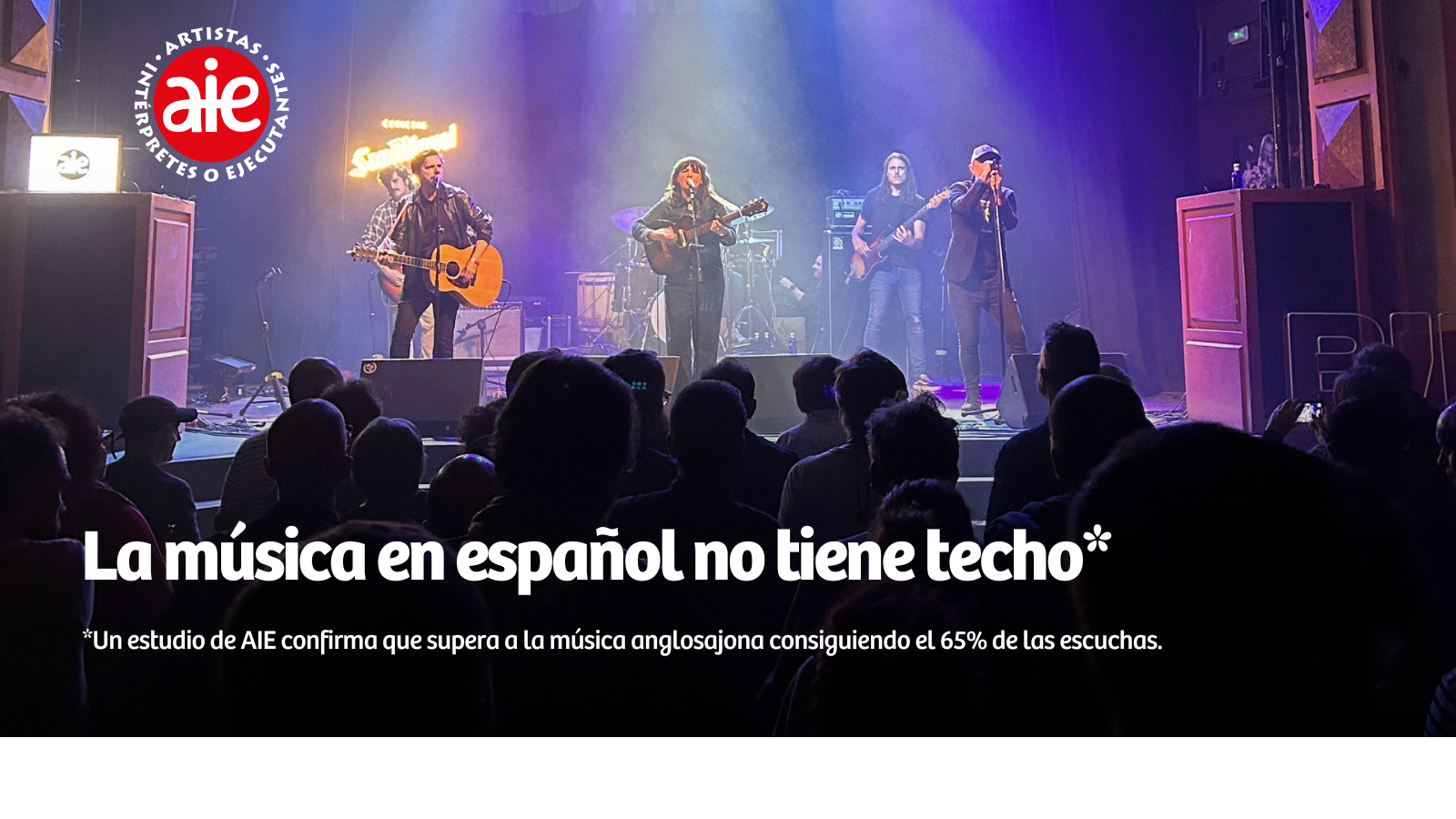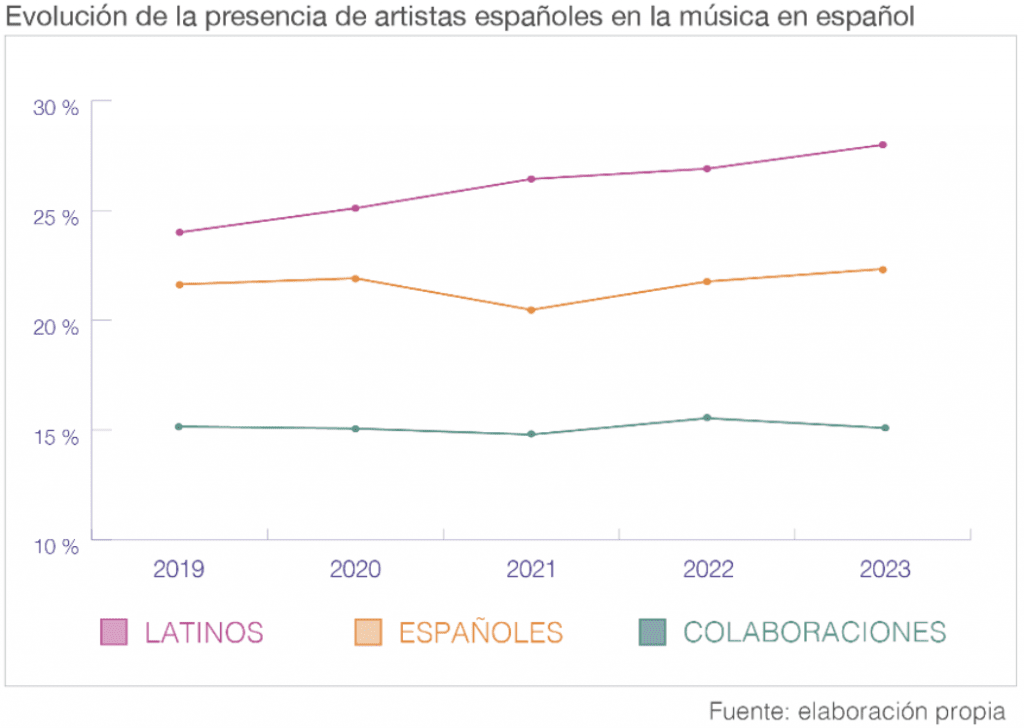Karol G, Bad Bunny, Rosalía y Quevedo entre los preferidos por los oyentes españoles.
Spanish Music Has No Ceiling
La música en español desbanca a la anglosajona en España: el 65% de las escuchas en plataformas ya son en nuestro idioma, y las colaboraciones entre artistas latinos y españoles copan ya un 15% de la cuota de mercado, según un estudio de AIE.

In 2023, Spanish-language music dominated playlists in Spain across both digital platforms (music streaming services) and traditional media (radio and television). It now accounts for 65% of digital streaming, reflecting an increase of over two percentage points compared to 2022, according to data from studies conducted by the Society of Performing Artists AIE.* This year’s figures confirm that Spanish-language music continues to thrive and that the upward trend identified in previous analyses persists.

This is a very positive result, especially considering that Spanish-language songs uploaded to digital platforms account for less than 40% of all tracks available. This is the opposite of what we see with English-language music: although English songs make up nearly 42% of the tracks on platforms, they represent only about 26% of total streams.

This phenomenon is part of a global trend, as highlighted in Luminate’s 2023 Year-End Music Report. The report analyzed the 10,000 most-streamed songs worldwide and found that the share of English-language tracks had dropped by 3.8%—a percentage that shifted in favor of Spanish-language songs. As a result, Spanish now ranks as the second most-listened-to language globally when it comes to music.

Music, especially urban music, has become an important channel for promoting and strengthening the Spanish language, as highlighted in the study The Boom of Latin Urban Music and the Global Expansion of Spanish by the Nebrija Foundation and University.
It’s no surprise, then, that this type of music also draws interest from non-Spanish-speaking audiences. A 2023 consumer study by Luminate in the United States supports this, showing that 24% of respondents listened to music in Spanish, even though Hispanics make up only 19% of the population.
It is undeniable that Spanish-language songs have become universal. Migration, cultural shifts, and, above all, the growth and accessibility of music streaming have made this music appealing worldwide.
Despacito, by Luis Fonsi and Daddy Yankee, paved the way for urban music with reggaeton at the forefront. Now, Latin music is expanding with genres that were once considered niche. Among them, Mexican regional music made a notable impact in 2023. Songs like Ella Baila Sola by Eslabón Armado and Peso Pluma, and Según Quién by Maluma and Carin León, became major hits on streaming platforms and social media. In the United States, this subgenre saw a 60% increase in popularity, becoming the standout trend of 2023, according to Luminate’s Year-End Music Report.
Back in Spain, AIE data shows that Mexican regional music has increased in streams compared to 2022, though not as significantly as in the U.S. Puerto Rican artists, led by Bad Bunny, and Colombian artists, with Karol G at the forefront, remain the favorites among Spanish listeners. However, Mexican songs with over one million streams on platforms have grown by 69% over the past five years.

A clear reflection of this success on Spanish radio and streaming platforms can be seen in concerts. In 2023, major Latin artists like Karol G (with four sold-out shows at the Bernabéu), Luis Miguel, and Duki toured Spain with great success. Additionally, the number of Latin music festivals continues to grow, with events like Vive Latino, Boombastic, and Reggaeton Beach Festival.
This trend appears unstoppable, especially considering that musical trends in Spain often follow those in the United States. According to the latest data from the 2024 Mid-Year Latin Music Revenue Report by the RIAA, the American association representing most U.S. record labels, Latin music revenues in the U.S. saw a 7.3% year-over-year increase in the first half of 2024, reaching $685.5 million and setting a new record.

In addition to the increasing presence of Latin artists in the most-streamed songs, Spain has also seen a one-point growth compared to last year in songs performed exclusively by Spanish artists. Singers such as Quevedo, Rosalía, Saiko, Aitana, Rels B, and Morad have managed to dominate the charts week after week. This phenomenon creates a synergy between Latin American and Spanish artists, materialized in collaborations that boost their careers in both markets. In the past five years, with the rise of urban music in Spain, collaborations between Latin and Spanish artists on streaming platforms have remained steady, reaching 15% of the market share. For instance, in 2023, nearly 11% of these collaborations surpassed one million streams, with hits like the Bizarrap and Quevedo session or Formentera by Aitana and Nicki Nicole standing out. It’s important to remember that, although urban genres dominate streams, Spanish-language music encompasses other genres, such as pop and indie.
For this reason, one of AIE’s main focuses is positioning and internationalizing music, as demonstrated by its role as the official sponsor of one of the most significant global events for Spanish-language music, the 25th Annual Latin GRAMMY Awards®, which will take place in Miami on November 14.
AIE’s primary objectives are to promote music and protect the rights it generates. To achieve this, the organization combines a strong commitment to technology with a leading member support service, helping artists optimize their royalties in the most fair way possible. AIE also offers the greatest global coverage, thanks to reciprocity agreements with counterpart organizations.
*AIE annually analyzes data for Spain corresponding to more than 60 million songs played on major radio stations and digital platforms. Internationally, it monitors nearly 700 radio channels across 57 countries.


